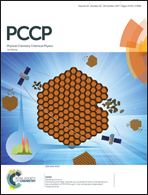Enhanced piezoelectricity of monolayer phosphorene oxides: a theoretical study
Abstract
Two-dimensional (2D) piezoelectric materials have potential applications in miniaturized sensors and energy conversion devices. In this work, using first-principles simulations at different scales, we systematically study the electronic structures and piezoelectricity of a series of 2D monolayer phosphorene oxides (POs). Our calculations show that the monolayer POs have tunable band gaps along with remarkable piezoelectric properties. The calculated piezoelectric coefficient d11 of 54 pm V−1 in POs is much larger than those of 2D transition metal dichalcogenide monolayers and the widely used bulk α-quartz and AlN, and almost reaches the level of the piezoelectric effect in recently discovered 2D GeS. Furthermore, two other considerable piezoelectric coefficients, i.e., d31 and d26 with values of −10 pm V−1 and 21 pm V−1, respectively, are predicted in some monolayer POs. We also examine the correlation between the piezoelectric coefficients and energy stability. The enhancement of piezoelectricity for monolayer phosphorene by oxidation will broaden the applications of phosphorene and phosphorene derivatives in nano-sized electronic and piezotronic devices.



 Please wait while we load your content...
Please wait while we load your content...